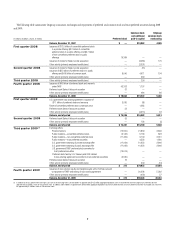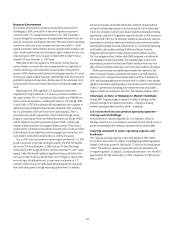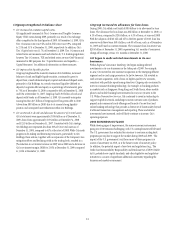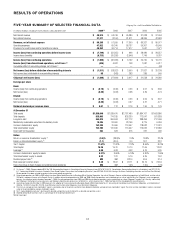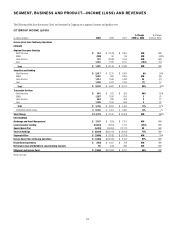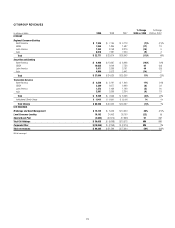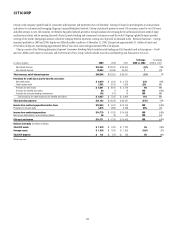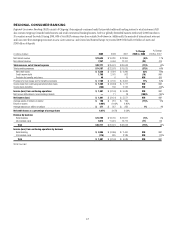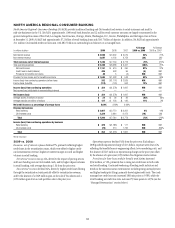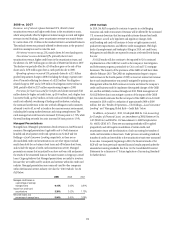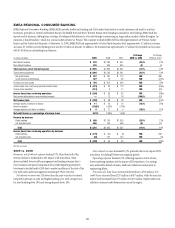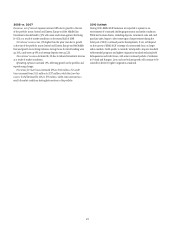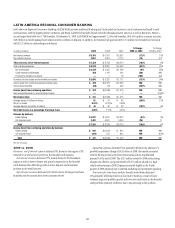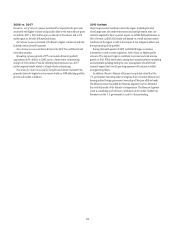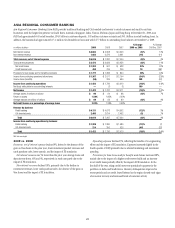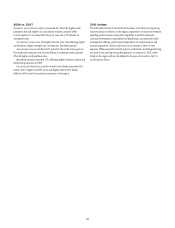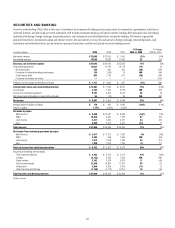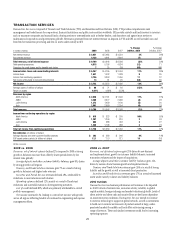Citibank 2009 Annual Report Download - page 29
Download and view the complete annual report
Please find page 29 of the 2009 Citibank annual report below. You can navigate through the pages in the report by either clicking on the pages listed below, or by using the keyword search tool below to find specific information within the annual report.
19
2008 vs. 2007
Revenues, net of interest expense decreased 21%, driven by lower
securitization revenue and higher credit losses in the securitization trusts,
which were partially offset by higher net interest margin in cards and higher
revenues in retail banking. Lower securitization revenue was mainly driven
by a write-down of $1.1 billion in the residual interest in securitized balances.
The residual interest was primarily affected by deterioration in the projected
credit loss assumption used to value the asset.
Net interest revenue was up 21%, mainly driven by lower funding costs.
Non-interest revenue decreased 39%, primarily due to lower
securitization revenue, higher credit losses in the securitization trusts, and
the absence of a $297 million gain on the sale of MasterCard shares in 2007.
This decline was partially offset by a $349 million gain on the sale of Visa
shares and a $170 million gain from a cards portfolio sale in 2008.
Operating expenses increased 31%, primarily driven by a $2.3 billion
goodwill impairment charge in 2008. Excluding the charge, expenses were
down 5% mainly reflecting the absence of a $292 million Visa litigation-
related charge in 2007 and a $159 million Visa litigation reserve release in
2008, partially offset by $217 million repositioning charges in 2008.
Provisions for loan losses and for benefits and claims increased $540
million driven by higher net credit losses, up $165 million, and a higher loan
loss reserve build, up $367 million, in both cards and retail banking. Higher
credit costs reflected a weakening of leading credit indicators, including
the continued acceleration in the rate at which delinquent cards customers
advanced to write-off, as well as trends in the macroeconomic environment,
including the housing market downturn and rising unemployment. The
cards managed net credit loss ratio increased 191 basis points to 5.72%, while
the retail banking net credit loss ratio increased 14 basis points to 3.54%.
Managed Presentations
Managed-basis (Managed) presentations detail certain non-GAAP financial
measures. Managed presentations (applicable only to North American
branded and retail partner credit card operations in NA RCB and Citi
Holdings—Local Consumer Lending, respectively, as there are no
deconsolidated credit card securitizations in any other region) include
results from both the on-balance-sheet loans and off-balance-sheet loans,
and exclude the impact of credit card securitizations activity. Managed
presentations assume that securitized loans have not been sold and present
the results of the securitized loans in the same manner as Citigroup’s owned
loans. Citigroup believes that Managed presentations are useful to investors
because they are widely used by analysts and investors within the credit card
industry. Managed presentations are commonly used by other companies
within the financial services industry. See also the “2010 Outlook” for NA
RCB below.
2009 2008 2007
Managed credit losses as
a percentage of average
managed loans 9.14% 5.62% 3.81%
Impact from credit card
securitizations 3.30% 2.02% 1.13%
Net credit losses as a
percentage of average loans 5.84% 3.60% 2.68%
2010 Outlook
In 2010, NA RCB is expected to continue to operate in a challenging
economic and credit environment. Revenues will be affected by the continued
U.S. economic downturn that has impacted customer demand and credit
performance, as well as by legislative and regulatory changes. Both
retail banking and cards will continue to focus on tight expense control,
productivity improvements, and effective credit management. With high
levels of unemployment and bankruptcy filings in 2010, net credit losses,
delinquencies and defaults are expected to remain at elevated levels during
the year.
NA RCB results will also continue to be impacted by Citi’s continued
implementation of the CARD Act as well as the company’s loss mitigation
and forbearance programs, particularly in Citi’s card and U.S. mortgage
businesses. The majority of the provisions of the CARD Act will have taken
effect by February 2010. The CARD Act implementation began to impact
card revenues in the fourth quarter of 2009 as lower net interest rate revenue
due to such implementation was partially mitigated by pricing actions.
Management within NA RCB continues to review and revise the company’s
credit card business model to implement the required changes of the CARD
Act, and this will likely continue throughout 2010. While management of
NA RCB believes that it can mitigate a portion of the impact of the CARD
Act, Citi currently estimates that the net impact of the CARD Act on NA RCB
revenues for 2010 could be a reduction of approximately $400 to $600
million. See also “Results of Operations—Citi Holdings—Local Consumer
Lending” and “Managing Global Risk—Credit Risk” below.
In addition, on January 1, 2010, Citi adopted SFAS No. 166, Accounting
for Transfers of Financial Assets, an Amendment of FASB Statement No.
140 (SFAS 166) and SFAS No. 167 Amendments to FASB Interpretation
No. 46(R) (SFAS 167). These new accounting standards will be applied
prospectively and will require consolidation of certain credit card
securitization trusts and the elimination of sale accounting for transfers of
credit card receivables to those trusts. Under previous accounting standards,
transfers of credit card receivables to the securitization trusts were accounted
for as sales. Consequently, beginning in 2010, the financial results of NA
RCB will vary from previously reported financial results prepared under the
amended accounting standards. See Note 1 to the Consolidated Financial
Statements for a discussion of “Future Application of Accounting Standards”
for further detail.


